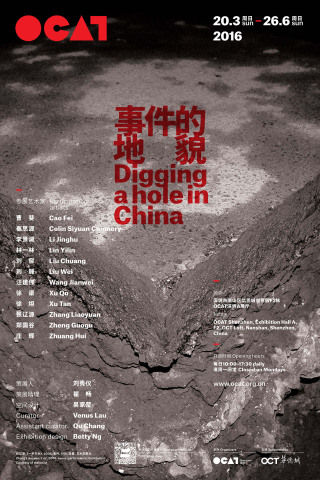
Arthub Favorite: Week Fourteen
As you all know, summer is on the way! Parks are abloom, jackets are being shed, travel plans are being made. If you’re still considering what to do for Labor Day or are looking to escape the stifling concrete sidewalks of Shanghai in June, then you might want to consider a trip to Shenzhen.
Arthub recommends a visit to OCAT Shenzhen to check the group show Digging a Hole in China, an exhibition worth visiting.
Duration: 20 March – 26 June, 2016
Venue: OCAT Shenzhen
F2 Building, OCT LOFT, Enping Road, Nanshan, Shenzhen, China
Artists: CAO Fei, LI Jinghu, LIU Chuang, WANG Jianwei, XU Tan, ZHENG Guogu, Colin CHINNERY, LIN Yilin, LIU Wei, XU Qu, ZHANG Liaoyuan, ZHUANG Hui
Curator: Venus LAU
Digging a Hole in China, features a range of works produced in contemporary China that bear a connection to land. The exhibition attempts to expose and analyze the discrepancies between this genre of work and “conventional” Land Art understood in the Western-centric art historical context, thereby probing the potential of “land”—as a cultural and political concept—in artistic practice.
In the late 1960s, changes in the cultural and social climate around the globe led a group of Western artists to desolate places—the so-called “nowhere.” These artists employed land-related materials in their artistic productions, and demarcated themselves apart from established systems of consumer society, capital, and rigid art institutions through their geographical retreat. To them, using land was a provocative and confrontational gesture with temporal-spatial properties exceeding the fleeting exchange-value and durability of commodities.
Meanwhile, in China, thousands of intellectuals were sent to rural regions as part of the “Down to the Countryside” (“shang shan xia xiang”) movement. Here, the concept of Land Art was imported from the West in the mid-1980s. While most of these works did not necessarily relate to their Western counterparts, and there were vast differences between the two contexts (Chinese Land Art did not necessarily take consumerism and the art market as a target, as consumerist society was still nascent), their concurrence nevertheless reveals intriguing correlations.
In the past three decades in China, society has gone through groundbreaking transformations, and ontological, sociological, and political conceptualizations of land have changed drastically: an exploratory and evolving process that has been represented in diverse forms in contemporary art. Produced at different points in time from 1994 onward, the works in Digging a Hole in China delineate the hidden trajectory of land’s conceptual evolution. This strand of art does not attack established systems in a belligerent and explicit manner, but instead subtly exposes the epistemological framework of land in order to open up new sites beyond it.
“Land” in the Western context was once a nowhere—a battle ground against various systems. In the present age, when Google Earth can teleport us anywhere with a single click, geographical distance seems to no longer offer new sites for criticism. In the face of the heated real estate market, land and capital becomes devotedly attached to consumer behavior; the sense of distance that “land” once possessed has slowly vanished, albeit with our further physical estrangement from the material. In a post-manifesto era far away from the birth of Land Art, the exhibited works engage a material plane that people share, generating fissures that can release yet unknown properties of the land—venturing into the waves while bundled up with land.
Click here for more details.